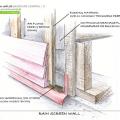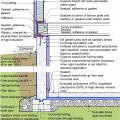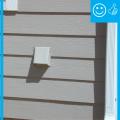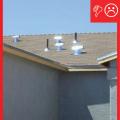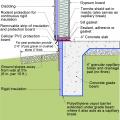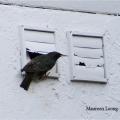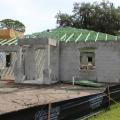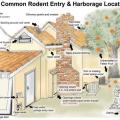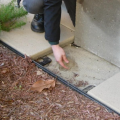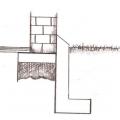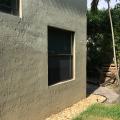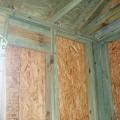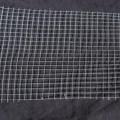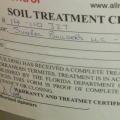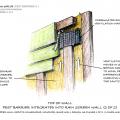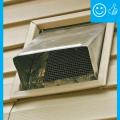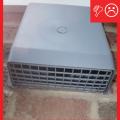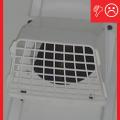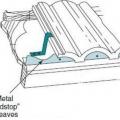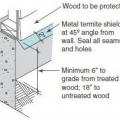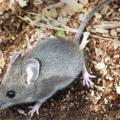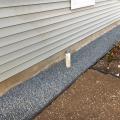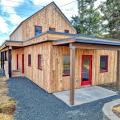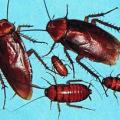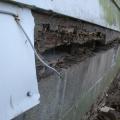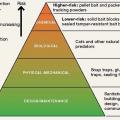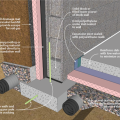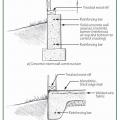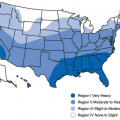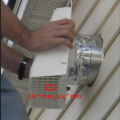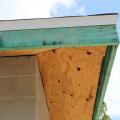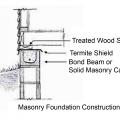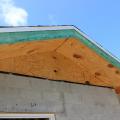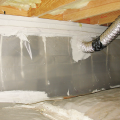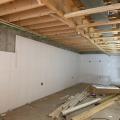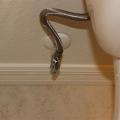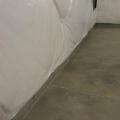Showing results 1 - 50 of 96
Install mesh insect barrier along the bottom of the rain screen behind the exterior cladding of above-grade walls
A cone or disc of plastic or sheet metal can be installed on pipes and downspouts to prevent rodents from climbing up the outside and gaining access to the roof
A layer of pea gravel or crushed stone, 4 inches thick and sloped 5%, provides a pest-resistant ground break around the perimeter of a slab foundation
A layer of pea gravel or crushed stone, 4 inches thick and sloped 5%, provides a pest-resistant ground break around the perimeter of a basement foundation
An externally insulated slab-on-grade is pest-protected by a metal termite shield under sill plate, metal-flashing-wrapped foam under siding, a removable inspection strip of PVC-covered foam, and 2 feet of gravel next to the foundation.
Bees made a nest in the drainage plane behind a brick veneer wall by entering via unscreened weep holes
Borate-treated roof trusses and concrete masonry unit (CMU) walls are among the pest-resistant features of these Florida homes.
Concrete (4 inches thick at 5% slope) provides a pest-resistant perimeter around the foundation
Concrete pavers set in 4 inches of sand provide a pest-resistant ground break at the building perimeter.
Construct a vertical curtain wall of 29-gauge corrugated iron, concrete, or bricks that extends down 2 feet and out 8 to 12 inches to prevent rats from burrowing under crawlspace foundations
Green Coast Enterprises uses termite-resistant borate pressure-treated lumber throughout its homes in New Orleans.
Hardware cloth, also known as wire mesh, can be used to prevent rodents from entering the home
In some locations, new homes may require certification of soil treatment for termites.
Install mesh insect barrier along the tops and bottoms of the rain screen behind the exterior cladding of above-grade walls.
Install termite shields and use solid concrete or filled concrete block for the top of foundation walls to deter termites and other pests
Metal birdstop is installed at the eaves of a tile roof to keep out birds, bats, rodents, and flying insects
Metal termite shields make it easier to see termite tunnels and may discourage termite access to wood framing
Pest prevention can be as simple as 4 inch thick gravel or crushes stone around the perimeter and extending two feet out from the house.
Pest proofing of this unvented crawlspace includes a metal termite shield that extends out from the sill plate, metal flashing wrapping the bottom of exterior rigid foam, and a termite inspection gap above interior rigid foam.
Pest protection measures include a termite shield under the rim joist and extending out on either side of the stem wall, insect screening under the furring air gap, and brick veneer to protect slab-edge insulation.
Preventive measures by builders can reduce the likelihood that termites will cause large-scale destruction later on.
Reinforce concrete slab and foundation walls to minimize future cracks that could let in pests
Right - A durable, vented cover is installed over this exhaust duct to prevent bird and pest entry
Right - An unvented attic with no soffit vents, borate-treated fascia board, metal drip edge, and concrete block construction on this south Florida home help make it resistant to hurricanes, pests, and wind-born wildfire embers.
Right - Make concrete masonry unit foundations more termite resistant by using a solid masonry block or bond beam for the top course, installing a termite shield, and using a borate-treated sill plate.
Right - Metal drip edge on this south Florida CMU home protects the top of the fascia and edge of the roof deck from water, wind-blown rain and embers, and insects.
Right - The basement foundation is insulated on the exterior and termite shield extends out past the top of the insulation.
Right - This crawlspace, which is insulated on the floor, has a complete vapor barrier over the floor and up the walls that is sealed at all seams and termite inspection gap at the top of the vapor retarder.
Right - This opening in the foundation wall around this pipe was filled with wire mesh then sealed with spray foam to prevent rodent and insect entry
Right - This unvented crawlspace is insulated along the walls and between the floor joists with 2-inch foil-faced polyisocyanurate; a termite inspection gap is visible above of the wall insulation and below the band joist.
Right – A termite inspection gap is left at the top of the rigid foam board basement wall insulation.
Right – An escutcheon is installed on this toilet tank pipe to help air seal around the pipe and prevent pest entry.
